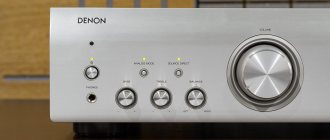Ultra-high video resolution, three-dimensional picture and expanded color gamut. This is what the advertising brochures of all modern video components repeat. How in demand are these qualities in home cinema and what remains behind the scenes? Let's check the capabilities of one of the most popular UHD players on the video market.
More than once I had to catch myself in a funny paradox. I enthusiastically welcome any new innovations in the world of music and hi-fi, but at the same time I desperately hold back and cling to the past when it comes to home cinema.
At first, I was perplexed by systems with thunderous sound on a TV screen the size of a small aquarium. Then I didn’t really like LCD-based projectors and TVs. Then the watercolor contrast of LCD TVs, on the contrary, turned into arc welding with chemical paints, which was also not at all similar to a normal film scan. In addition, the fashion for Motion Plus, barbaric color correction and 2.35:1 at home viewing caused severe allergies. In short, everything is wrong and in the wrong steppe.
In the end, the longest-lived components in my system were the source and projector. And if I am still in awe of the old king of three DLP chips Infocus SP777, then I have been trying to get rid of the Dune HD Prime 3.0 source for a long time and unsuccessfully. I'm so tired of him!
An upgrade that kept getting canceled
Look at the THD measurements, friends. After the odd 3rd harmonic in the dominant there is a palisade of peaks in the high-frequency region. Plus, they tend to grow as the device heats up. If you look for an example of the most lame and gray sound, then, without a doubt, it will be Dune. I've never heard anything worse, not even from the garbage dump discmen. We are, of course, talking about the HD Prime 3.0 analog outputs. And although these problems do not apply to HDMI, which I used, I still wanted to replace the “dune” with something new.
The nature of harmonic distortion of Dune Prime 3.0 based on a 1 kHz test signal (24 bit / 44 kHz).
In general, this is always a problem with high-quality solutions in a recreation center - pay and get half of the unnecessary filling in the load. It's the same story with AV receivers. All top devices are equipped with 11 channels, while in an ordinary room 5.1 would be enough, but the problem is that today it is difficult to find a 5.1 High-End AV receiver with modern format support.
At one time, attempts to switch from HD Prime 3.0 to something more compact from the same manufacturer ended in failure. It turned out that, unlike the Sigma Designs SMP8642, the new SMP8670 chips turned out to be a step back in terms of image processing. Oppo’s “universal sources” were considered an alternative, although it is not very clear what their versatility is.
The first Oppos couldn't function as a USB DAC when they needed it. And later models still wrapped redundant audio functionality around an optical drive that was completely unnecessary. Over a thousand dollars for a presentable appearance and about the same picture as on the old “dune”? Well, I don’t know... And then Oppo told everyone to live long.
New Hope
Therefore, against the background of everything we have experienced, I was very inspired by the new Sony UBP-X800. Like the late last-generation Oppo players, Sony UHD TVs use Mediatek MT8591 processors. It's just that Sony calls them more romantically - “X1 Extreme”. The same hardware is installed in the Sony UBP-X800.
At a price of less than three hundred dollars, the player reads just about all formats: up to MKV over the network or via USB. There is also an optical drive for Blu-ray UHD, SACD and DVD-Audio. At the same time, the device does not carry audio components - this is pure digital transport. Analogue outputs can be found in the top model UBP-X1000, but why do we need them?
For its own internal reasons, Sony does not supply either the X1000 or the X800 to Russia, Ukraine and Belarus. But there is no big problem ordering them abroad, the post office is still working. The serious hype on the forums around the UBP-X800 strengthened the desire to part with a relatively small amount of money, and after a couple of weeks I already had the player. The American device is not afraid of our voltage, since it has a pulse power supply. All that remains is to attach the adapter to the flat plug.
In terms of design, the Sony UBP-X800 is identical to the Dune HD Prime 3.0. That is, almost nothing has changed in ten years! Of course, I understand the desire of manufacturers to squeeze these fish cutting boards into narrow slots under TVs, but I would still prefer blocks that are not so stretched. Let them be like Cyrus components or Stax amps - that's my favorite format.
Minimalism or corporate greed?
The chassis of the Sony UBP-X800 is made quite rigid, and there is no free space inside. Still a pre-top unit. With one palm it is quite difficult to hold a weight of almost four kilograms with such windage. In general, the UBP-X800 resembles the previous UHP-H1 model, although now the tray folds back a glossy plastic cover along the entire front of the case. Why is not too clear.
The Sony UBP-X800 does not have any display - look for the menu on the TV. And if I want to play a CD or audio over the network, do I turn on the projector lamp? The network, by the way, is still 100 megabit. The Video & TV SideView control mobile application does not want to duplicate the menu, but only displays the functions of the remote control.
By the way, like Dune, it disappoints with the lack of backlighting. However, this laconicism also has its own positive side - no more blue lights a la “Priora is going to a wedding.” The operation of the device is indicated only by a tiny LED, the size of a poppy seed. And it's finally green!
Yes, some things in modern sources have changed for the better. Now there is a built-in Wi-Fi receiver, and Bluetooth LDAC has appeared for broadcasting to headphones or a wireless speaker. But the USB connector for connecting external media is located behind a snotty plastic cover, ugh!
When starting up, the Sony transport is much quieter than the Dune, which, with its nasty whistle of the Sunext drive, each time convinced me of the idea of completely abandoning optical media. Well, finally a pleasant surprise from Sony! But that was not the case - look at the screen. Of the Internet resources, only Netflix is highlighted, for which there is even a separate button on the remote control. Youtube was not in our location, although it was advertised in Western advertising. There is no talk about other browsers.
The former Opera TV (VEWD) came to life, promising to close in a month - one of the useful things in it was the music video channel Vilanoise with non-obnoxious playlists of indie and hip-hop. It was nice to see all this on the projector, no doubt about it. Quick readiness to start is confirmed by a signal on the external DAC, even in off mode. The device essentially only turns off its LED, and itself is on duty over the network.
What is more important - DVD or HDR?
There are a number of questions regarding 4K releases, including re-releases of old films. Mastering and special effects are still done in 2K, as professional video production tools have not kept up with the regular announcements of ultra-high-resolution displays. This can be seen by comparing Blu-ray and UHD footage from Alien: Covenant. There is no difference in the detail of the picture.
The results of new HDR remasters are also often quite contradictory. The color palette of The Big Lebowski, which looked exemplary even on videotape, suddenly turned mustard yellow in the 2022 anniversary UHD Blu-ray edition.
Which version do you like best? The first screen was taken from HD DVD (2007), the second was made from UHD Blu-ray (2018)
Therefore, for now, let’s leave out 3D, HDR, Atmos and other attractions that are not available in a classically designed cultural center. You can read many reviews on this topic, and it is clear that the Sony UBP-X800 performed exemplary in these genres. This is what it is designed for. The only exception is the absence of Dolby Vision, which will be in the UBP-X800 mk2 model, which is due out in May and will cost slightly more.
I was primarily interested in how the new source would cope with regular SD and HD content. And this is a completely reasonable question. After all, a lot of interesting movies still haven’t received the honor of HDR, even Blu-ray is unlikely to get it. Being connected via Wi-Fi, the UBP-X800 quite confidently carried video with an average (6 Mbit/s) bitrate, although to fully guarantee against failures, it is, of course, better to use optical, USB or wired Ethernet.
But the most unpleasant thing is that there is no longer direct access to folders, like Dune. Everything is sorted into “photo”, “music” and “video” sections. So, the first bummer is that DVD images cannot be read. And there is no need for accusations of piracy, I copied many DVDs onto a hard drive a long time ago. This makes sense for media up to 9 GB, unlike UHD Blu-ray, which takes up an order of magnitude more memory.
Copies of DVDs, of course, are displayed in the “video” section, the folder opens, but the disc menu will not launch. Therefore, you will just have to launch VOBs as a list of files. It's the same story with Blu-ray. Experienced users advised creating an AVCHD folder on a USB drive, where to put all the files, but it seems that in the next firmware Sony has covered up this option too.
4K Ultra HD Blu-ray player Sony UBP-X700
4K Ultra HD Blu-ray player Sony UBP-X700 is a Blu-Ray, DVD-Video and SACD player.
This is a modern audiovisual playback device, and if you want to use new products in your setup, then in fact you simply have no choice. Although the Ultra HD Blu-ray standard appeared relatively recently, in February 2016, device manufacturers responded to this event with a huge lag, which can only be caused by the lack of sufficiently powerful hardware solutions at the chip level or the desire to see the market reaction. In 2016, Mediatek released a chip focused specifically on 4K video for integration into 4K Blu-ray players - MT8581 (for example, in the Sony UBP-X700), which manufacturers began to actively use (for lethargy). Panasonic, however, for top-end solutions preferred a different (according to reviews, better image quality) chip, installing Mediatek only in budget options.
Let's take a closer look at the specifications of the MT8581 chip. CPU: 4-core ARM Cortex-A53 @ 1.3GHz 64-bit Gigabit Ethernet, USB 2.0, USB 3.0 GPU: Arm Mali-T860 MP2 Display resolution: 1920 x 1080, 3840 x 2160 Audio: AAC(+), Dolby Technologies , Dolby TrueHD, DTS Master HD, DTS Technologies Video: H.264, H.265 / HEVC, MPEG-1/2/4, VC-1, VP-8, VP-9 Media support: DVD, Blu-ray, 4K Blu-ray
The goal of such chips, of course, is to decode audio and video streams in real time with maximum quality at the hardware level. The end device on such chips is able to decode a video stream with a resolution of up to 4K without drops in the number of frames (60).
In general, the story of promoting the 4K format smacks of advertising. I'm not against 4K resolution, but on the contrary, because this is the option that is necessary for large screens. Here it is probably appropriate to move away from the concept of resolution and adopt the expression “retina” from Apple.
Retina is the number of pixels on the screen at which you are unable to distinguish these same pixels. Of course, this is affected by both the screen size (the larger it is, the larger the pixels at the same resolution on different screen sizes), and the distance to the screen. Therefore, the concept of “retina” is more appropriate than 4K. Since 4K does not guarantee the absence or presence of a grid of pixels - everything is relative (screen size, resolution, distance to the viewer), but retina guarantees it, although remaining within the strict limits of the given boundary conditions. It can be argued that 4K significantly improves picture quality, since this resolution is 4 times higher than FullHD equal to 1080p. But this is advertising demagoguery.
Firstly, why is it that when talking about FullHD, a resolution of 1920x1080, the height of the screen (1080) is taken as a reference, and for 4K (3840x2160) they indicate the width size for no reason? It is clear that due to advertising slogans, the transmission of the idea that 3840 is more than 1080 looks more impressive than the true 1080 vs 2160. On the other hand, on a screen with a width of 3840 pixels you can fit 4 screens measuring 1920x1080. But then it made sense to call it something like 4x (2160p), and not 4K.
The second moment is purely everyday. On the Samsung NU7140 TV with a 65″ (165 cm) diagonal, I can’t distinguish pixels, not just from the sofa, but literally with my nose buried in the screen, both at 4K and 1080p movie resolution.
From this, the logical conclusion arises that since there is no difference in image quality on TV up to 65″ between films in the FullHD format (1920x1080) distributed on Blu-Ray and a variation of the film on 4K Ultra HD Blu-Ray (3840x2160), then no the need to purchase more expensive 4K Ultra HD Blu-Ray media.
Theoretically, this is true, the resolution quality is approximately comparable to the eye, but strangely enough, the strength of 4K lies not only and not so much in the higher resolution, but in the use of HDR technology. Sometimes you can also see holivars on the topic that the new 4K Ultra HD Blu-Ray player does not support Dolby Vision technology, but only supports HDR. This doesn't make any sense per se—Dolby Vision is essentially a synonym for the acronym HDR. This is the same process, named by different companies for their own process. The essence of HDR/Dolby Vision is to increase the brightness in certain areas of the image by 100 times. This allows you to see subtle transitions of halftones and details both in the darkest places with a coal-black color, and in bright ones.
HDR (High Dynamic Range) is, I think, the most significant plus in favor of 4K Ultra HD Blu-Ray. The same film, but with HDR technology it looks much better, it’s richer, it’s brighter, it’s more colorful and colorful. After 4K HDR, regular Blu-Ray films look like films with a faded color palette. Therefore, films released on 4K Ultra HD Blu-Ray have a great advantage.
But of course not everything - it matters when the film was shot - if it is a modern film shot on a digital camera, then we get a luxurious, detailed picture with a minimum of dirt.
If this is an older film, then the grain of the film emulsion will be visible (unpleasant trembling goosebumps), the picture will be softer, read insufficiently clear, etc.
Film Groundhog Day, 1993, film digitized in 4K
I will also add that the vast majority of modern films are shot on digital cameras with 2K resolution and this is a luxurious quality. As an example, look at the film Oblivion with Tom Cruise and Kurylenko, which was shot on 2K - the picture is magnificent.
There is a resource on the Internet https://4kmedia.org/real-or-fake-4k/ that indicates whether the film is truly 4K in resolution or is it a fake 4K. My opinion is that this is a fundamentally incorrect classification, which throws the baby out of the basin with the bath water. The site mentioned above is guided by the dogma that a film, no matter what quality, what grain size, etc., can be digitized with any high resolution, as long as the scanner allows it. You can digitize film in 4K or 6K or more.
According to the logic of 4kmedia.org, this is true 4K. What about the fact that the image from the film is more cloudy, or as they say, “soft” and the grain emulsion of the film is visible? The guardians of 4K don't care at all. If we turn to films shot on a digital camera in 2K, which are called 4K Fake on the website, we will subjectively note that the picture in digital is cleaner and clearer, more of the finest details of the image are visible, i.e. The picture is generally of higher quality.
Is 4kmedia.org wrong? My point of view is that neither the film (no matter what resolution it is digitized with, because here the role of a limiter in the face of the finite quality of the film itself is already noticeable - looking at the garbage from the emulsion makes no sense if the actor’s face does not become more detailed from this in detail), neither 2K digital is true 4K. The tape cannot be 4K due to its analog origin, the limitations of the film related to the chemical properties of the components from which it is made, which have limitations in a number of important points.
And the figure 2K cannot be 4K due to the fact that it is truly 2K. Why are (most) films called 4K if they are not? I see the reason precisely in the hybridity of the base material. The tape is digitized into 4K by a scanner, although its quality cannot compete with the quality of digital 4K cameras, and accordingly, all that remains is to upscale shooting from digital 2K cameras to 4K and claim that this is 4K quality. Obviously, all of these films are not 4K. That’s why there is no noticeable difference in quality (in terms of detail) between classic 1080p Blu-ray films and 4K, except for HDR. Your opinion may differ from the one stated here in this matter, but if your ultimate goal is the highest image quality, then I advise you to pay attention to films shot primarily with digital cameras. Although even from modern “film” films you can get a very decent picture, an example is Interstellar (Nolan) shot on analog film.
There are also truly over 4K creations in cinema - for example, Peter Jackson's Hobbit trilogy, shot digitally in 5K at 60 frames per second.
I will also note that digital film cameras are somewhat different from those built into your smartphones. “Cinema” digital cameras are designed to create the illusion of shooting with a regular “analog” camera; all these tricks with focal length and so on are present in full, in addition to the excellent picture quality. I’ll also add a fact that is not known to everyone - feature films are not shot with one camera. During the filming process, different cameras are used. They try to shoot the most significant moments with expensive high-quality cameras that are rented, while simpler scenes are more than necessary (depending on the budget). Therefore, the picture in films is heterogeneous and unequal - there are places with rather dirty and unclear shooting, which are replaced by absolutely perfect shots taken on a different camera. As an example, I propose to look at the list of which cameras were used to shoot the great film Justice League, where even in the 4K release you can easily distinguish ideal locations shot digitally and more “noisy and grainy” ones shot on film.
Justice League Filming: April 11, 2016 - October 14, 2016 Aspect ratio: 1.85:1 Cameras: Arri Alexa 65, Hasselblad Prime 65 Lenses Arri Alexa XT, Leica Summilux-C Lenses Arricam LT, Leica Summilux-C Lenses Arricam ST, Leica Summilux- C Lenses Arriflex 235, Leica Summilux-C Lenses Arriflex 435 ES, Leica Summilux-C Lenses Copy format: 70 mm (blow-up) (Kodak Vision 2383) D-Cinema (also 3-D version) Shooting format: 35 mm ( Kodak Vision3 50D 5203, Vision3 250D 5207, Vision3 500T 5219) Codex Image: color
Yes, the world will never be the same now.
Another point comes from the fact that a mixture of cameras is used, both digital and analogue, and the frame size is also different. It was in the popular great sci-fi movie Nolan's Interstellar, and so on. They even came up with an excuse for this, in connection with its use in IMAX. Now is the time to move on to equipment on which you can view this newest (ala 2016) 4K Ultra HD Blu-ray format, and not become a fossil, upon finding which archaeologists will say - this guy was still watching DVDs in 2022, I hope not in the composite . If you are now thinking of delving into the analytics of the offered models before going to the store to buy something, moderate your ardor, “young man,” and better cherish it so that it does not cool down. After reading reviews from the network, it may seem that the choice is quite wide, there are UHD Panasonic, Oppo, and Sony...
There really aren't many options available other than Sony. And perhaps the very expensive Pioneer UDP-LX500-B (110,000 rubles). The only affordable UHD model that is supplied to Russia is the Sony UBP-X700, which is sold out almost everywhere, and remains only where the price for it was raised by 5 thousand (pult, audiomania). And then, only Sony UBP-X700 is supplied, and the more advanced X800M2, X900, X1000 are not supplied. And this means not only the lack of a guarantee if you decide to buy it yourself abroad, but also the rake that you will run into in the form of regional protection in Blu-Ray and DVD, etc. Regional protection was abandoned in 4K UHD Blu-Ray. Based on the picture in the reviews, they recommend the 4K player Panasonic DP-UB820, but in Russia it is not sold, like the new model 9000. Oppo no longer produces popular Chinese and very expensive media players, the last one, as far as I know, was 205. Perhaps I'm exaggerating, go shopping and write in the comments what other 4K UHD Blu-Ray players are available for sale. Due to the lack of choice, he returns to the Sony UBP-X700 model, as the only one that can actually be bought within the range of 250-300 dollars.
Compared to audiophile audio components, this seems extremely affordable, but do not forget that the video equipment market is even now much wider and more popular than the audio sector.
Sony UBP-X700 Sony UBP-X700 is a fairly small device - 320 x 45 x 217 mm (WxHxD) and weighs only 1.4 kg. The body is made neatly. The kit includes a high-quality remote switching power supply similar to a laptop. The convenient, shortened remote control has a wide reach; there is no need to point it directly at the player. There are two hidden buttons on the front “mirror” panel - power on and tray eject. When you press “eject,” the front panel opens like a downward door and the Blu-ray drive tray slides out.
The player operates virtually silently, which contrasts both with the Xbox One S, which is also a 4K Ultra HD and 3D player, and with the Playstation 4 and 3, which are not 4K capable, as well as with the LG BD550 player. A comparison of picture quality between all these players and more is in the second part of the review. The Sony UBP-X700 can play SACD and CD discs, but if you don’t have a receiver, then I can’t imagine how to replace it - SACD is transmitted only via HDMI, the device has no analog outputs. An interesting feature of the Sony UBP-X700 4K player is the ability to connect an external hard drive to it via USB 2.0. I read reviews that movies from the hard drive on this player are slow and you have to watch them over Wi-Fi - this is not true.
I watched the 4K film Black Panther from my hard drive (an excellent quality transfer, almost standard) and it was shown perfectly, without any drops in frames (3840x2160, cinema 24 frames/sec).
Another test subject was the equally luxurious 4K UHD film Resident Evil “Afterlife”. It was demonstrated from an external hard drive via USB without any drop in speed.
On average, I observed a stream of up to 90 Mbps over USB without the slightest lag. On the Sony UBP-X700, I noticed a couple of times that it was incorrect to demonstrate the fast movement of an object, for example, in the film Valerian (a regular Blu-ray disc, not 4K) in the initial menu of the disc, a car was rushing through the desert and its movement was by no means uniformly accelerated. Rarely, but such phenomena can be noticed. Maybe once per film, or in general everything will be perfect. I don't think this deserves any attention.
For example, a rather complex scene at the beginning of the movie Transformers 3, where a large-scale space city is shown and the camera swoops down on it, is displayed wonderfully, without any jerking, with high detail.
One of the potentially tasty features of the Sony UBP-X700 is the ability to view HDR content (those 4K). In HDR, as I already noted, the image benefits significantly both in the richness of colors and in showing small details in the dark or in the light. The playback function from external media - a hard drive up to 2 TB with MBR partitioning, or 4 TB with GPT partitioning, or from a flash drive up to 128 GB really works very well and plays almost any format perfectly (but of course you can try to find something completely exotic). It shows from m2ts, from folders preserving the structure of a Blu-Ray disc it shows, from avi and the like it shows. Rewind is present.
Another question is that it is simpler, easier, more comfortable to buy a licensed 4K disc and just enjoy the film, rather than download 70-80 GB from torrents during long nights, and then copy them to an external drive, etc. But if you love challenges and your time is worth nothing, then no one will stop you.
Using the Sony UBP-X700 you get a bonus that is not available in the more expensive X800 model and is referred to as DV on forums. This is the ability to play regular Blu-ray discs with non-HDR movies with HDR. The original film on Blu-Ray does not contain HDR, but the Sony UBP-X700 player will emulate this feature and the film will be shown in, say, pseudo-HDR. This is potentially and theoretically a very big plus. But precisely that, theoretically, below I will describe why.
PICTURE QUALITY ON Sony UBP-X700 We will arrange a debriefing in the second part, but in order not to leave you completely without something sweet, I will note the main points. The picture shown is softer, probably some kind of anti-aliasing filter is activated, the search to disable it in the menu was unsuccessful.
Indirectly, disabling forced scaling to 4K and selecting Auto2 gave a slightly more detailed picture, but overall the detail suffers from poor quality. There are no clear, sharp edges on objects; they roll into an imitation of a film strip. Is this good or bad?
On the one hand, the image on both Blu-Ray and 4K UHD Blu-Ray is decent, but not as sharp, not as bright and detailed as we would like from Blu-ray. Perhaps I have not yet sufficiently studied the capabilities of the Sony UBP-X700 and have not enabled or disabled something in the settings, but I am a simple video lover. If I couldn’t turn it off, then most likely 10,000 other people won’t be able to turn it off either.
COLOR In this regard, the Sony UBP-X700 offers its own version of color interpretation - the picture appears darker, more film-like, and the colors are muted.
HDR Oh the sweet word HDR, which is worth buying a 4K player for. But I think this is not the case with the Sony UBP-X700. Not only are the colors and overall brightness muted on the device, but the HDR also looks rather unconvincing, so much so that it’s difficult to even understand whether it actually exists or not. On the Sony UBP-X700 itself, you will of course note that a film with HDR looks richer and brighter than a regular Blu-Ray. But players from other companies provide the same bright and rich picture on regular Blu-ray as Sony does in HDR - this is the irony, but on HDR content they are even richer and brighter. Therefore, the discussion about HDR emulation represented by the Sony UBP-X700 is a very relative achievement.
DVD PLAYBACK Of course, DVD films are catastrophically inferior in quality to Blu-Ray releases, but quite a lot of content exists/remains only in DVD format. These are both films and concert recordings. Many of these recordings, for various reasons, may never appear on Blu-Ray media.
And the Sony UBP-X700, thanks to the built-in soap, shows DVDs exceptionally well. Perhaps this is so striking because due to the muted colors and “blurred” display of Blu-Ray, this player displays Blu-ray below its capabilities, but DVDs are shown exceptionally well within the limitations of their format.
The 3D Sony UBP-X700 can play 3D Blu-Ray, but a modern 4K TV, unfortunately, cannot.
AUDIO There is no way to test audio except through the TV speakers, which is far from the dream of a movie theater. The Sony UBP-X700 can play SACD and CD audio discs and, of course, Blu-Ray audio. But DVD-Audio was left out; the player will not be able to play this format.
IN CONCLUSION OF PART ONE Movies on Blu-Ray and 4K Ultra HD Blu-Ray offer exceptional picture quality. Yes, the image still hasn’t gotten rid of grain or debris in the frame, “thanks” to the hybrid filming technique, as mentioned earlier, but in general, video fans received incredibly high-quality images at home, not only rivaling cinematic quality, but sometimes and superior. Sony UBP-X700 is the last of the Mohicans, which you can still buy in retail stores and get a powerful 4K Ultra HD Blu-Ray player and the ability, in addition to discs, to watch content from HDDs and flash drives. Blu-Ray is a huge step up in quality over DVD, and if you haven't picked it up yet, don't put it off until tomorrow. And in the second part you will find a grand comparison of picture quality (FüllHD and 4K UHD) Blu-Ray players, in the battle for the eyes of a video fan you will face: 1. 4K Ultra HD player Sony UBP-X700
2. Blu-Ray player LG BD550
3. Game console Xbox One (Blu-Ray)
3. Game console Xbox One S (4K UHD Blu-Ray)
3. Playstation 4 (Blu-Ray)
3. Playstation 3 (Blu-Ray)
Is it possible to use game consoles as Blu-Ray players, are they inferior in picture quality to stationary players, and other questions will be answered in the next part. If you liked it, leave comments, and also be sure to visit the YouTube channel of the Around Stereo site, which is an integral part of this site.
Blind tests are also useful for videos
Now about the video quality. Frankly speaking, two devices released ten years apart did not show any difference at SD resolution projected on a 110-inch screen. Well, maybe Sony had the advantage, but it was such an insignificant value that it was not recorded in any way in the blind test. On good HD videos, the advantage of the UBP-X800 was a little more obvious, but, again, only after a very close look.
Moreover, the peculiarity of the Dune picture was such that it did not look cloudy or low-contrast, as happens when comparing lens optics. Dune looked, let's say, more severe, and this slight dirtiness never particularly bothered me, since it gave the video the impression of a direct scan from the film, a flat transfer with grain. In contrast, Sony presents a more polished, glamorous image. But all these are too strong epithets - the reality is not so dramatic.
In addition, Sony has several gradations of image settings, unlike Dune, but I was satisfied with everything by default. Unless I had to switch the image type to “projector”. Additionally, for non-HDR displays, the Sony UBP-X800 offers a built-in HDR to SDR converter. To convey, so to speak, the delights of technology to the uninitiated. The converter has five gradations, but in all cases the result looked rather strange. The signature red letters on the Netflix splash screen turned orange, and the shadows were lightened, depriving the picture of depth.
Video quality
The Sony UBP-X700 produces a truly impressive picture. Even those accustomed to 4K are usually mesmerized by the clarity of the images when playing HD Blu-ray. Every leaf, every blade of grass looks completely alive. People, the details of their clothing and the shadows of the interior are conveyed naturally and realistically.
This is facilitated not only by the clarity of Ultra HD 4K, but also by the widest color range and natural color reproduction reproduced by the UBP-X700 player.
HDR10 and Dolby Vision show their superiority in creating natural images on the screen. Of course, a large part of image quality depends on the display, but just compare the image of the X700 and any other Blu-ray disc player to see that these words are true.
conclusions
These were all visual experiments. There is nothing more to say about audio transmission via HDMI. Someone on one of the forums claimed that the UBP-X800 even has better sound via HDMI than the Oppo, but such a level of enlightenment is not yet available to me.
Overall: with the UBP-X800 I got quiet optical transport, 3D and UHD goodies that I didn’t need, and an extremely insignificant increase in video quality at high bitrates. With parity in unsuccessful non-backlit remote controls, control applications and form factor, Dune HD Prime 3.0 still has normal access to folders and full-fledged work with DVD and Blu-ray disc menus.
Is it a lot or a little? Probably a lot. In the sense that there was a lot of video equipment. And, alas, it was not possible to part with the boring Dune HD Prime 3.0 once again. Now I will get bored with both devices.
Official website: Sony UBP-X800
Price: $228 (Amazon, excluding shipping)
UBP-X700 Specifications
| ARE COMMON | |
| type of product | Blu-ray disc player |
| Manufacturer | Sony Corporation |
| Model number | UBPX700BCEK |
| Name | UBP-X700 4K UHD |
| INTERFACE | |
| HDMI | Yes |
| USB | Yes |
| AUDIO | |
| Formats | CD-DA, SACD, AAC, DSD |
| Sound system | Dolby Atmos, Dolby TrueHD, DTS:X |
| TECHNICAL | |
| Peculiarities | 4K upscaling, Bluetooth, Mirroring |
| 3D type | 3D |
| Number of disks | 1 |
| Media formats | BD-R, DVD-R, CD-R |
| NET | |
| Streaming service | Spotify |
| Wireless LAN | Yes |
| PHYSICAL | |
| Width | 32 cm |
| Depth | 21.7 cm |
| Height | 4.5 cm |
| Weight approx. | 1.40 kg |
| Color | Black |
| VIDEO | |
| Sweep mode | Progressive |
| Format | 2160p |
| Video media formats | BD Video, DVD Video |
Price UBP-X700 Currently (February 2018), the player is available for purchase in some online stores at a price of 248 euros (approximately 14,000 rubles). In the near future, it is expected to be available in retail chains, and therefore in the Russian Federation.
UBP-X700 Review Summary
In conclusion of the review of the X700 from Sony, let's summarize.
This Blu-ray player offers an attractive price/performance ratio in terms of its omnivorous features and support for HDR modes. Those who have Sony TVs at home, or those who are planning to purchase a TV from the Sony 2022 line, can definitely recommend this Blu-ray player as a video source for their home multimedia system. Sony UBP-X700 review2018-08-11T12:03:33+03:00 Semen Players and devices players Most of the AV products from Sony's new lineup were announced at CES 2022, but very few were on display at the show. Therefore, today we will try to “personally” get acquainted with the new Sony UBP-X700 Blu-ray disc player. The previous model, BDP-S6500, which has built-in Wi-Fi, scaling up to 4K, but without HDR support, is available with...SemenSemen EditorUltraHD











